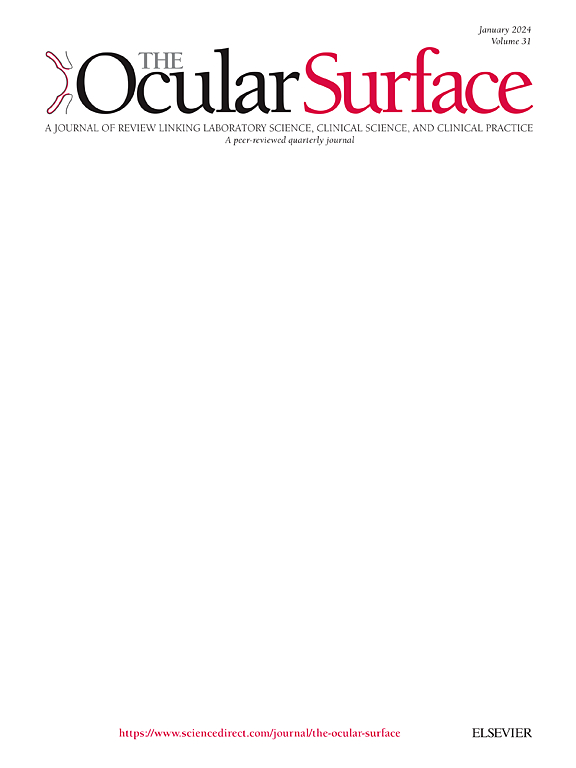Moxifloxacin-resistant and moxifloxacin-susceptible Staphylococcus aureus Keratitis: Outcomes from a 10-year retrospective study
IF 5.6
1区 医学
Q1 OPHTHALMOLOGY
引用次数: 0
Abstract
Purpose
Fluoroquinolones, specifically moxifloxacin are commonly used to treat bacterial keratitis. However, recent clinical evidence assessing the clinical outcomes in bacterial keratitis cases resistant to moxifloxacin remains sparse. This study evaluates the clinical characteristics and outcomes in cases of Staphylococcus aureus keratitis with in vitro resistance to moxifloxacin.
Design
Retrospective clinical cohort study.
Methods
Keratitis patients with cultures positive for Staphylococcus aureus at the University of Pittsburgh Medical Center, were identified between July 2012 and June 2022.
Results
A total of 104 patients with culture-confirmed Staphylococcus aureus keratitis were included in the study. Patients infected by moxifloxacin-resistant bacteria (n = 32) were significantly older (74.32 ± 17.41 years) than moxifloxacin-susceptible infections (55.56 ± 20.86 years, p < 0.0001). Moxifloxacin resistance was identified in 29.8 % of cases, including methicillin-susceptible (4.8 %) and methicillin-resistant Staphylococcus aureus (25.96 %) isolates. The most common risk factors for moxifloxacin resistance were ocular surface disease (35.5 %) and history of prior infection (32.2 %). Moxifloxacin-resistant Staphylococcus aureus was associated with larger epithelial defects (18.18 ± 4.93 mm2 vs. 5.10 ± 0.76 mm2, p < 0.0001), longer healing times (42.42 ± 6.75 days vs. 32.2 ± 3.56 days, p < 0.0001), and higher rates of corneal perforation (19.3 % vs. 4.2 %; p = 0.0317). Visual acuity outcomes were significantly worse in the resistant group, with minimal improvement from baseline (1.87 ± 0.14 LogMAR) to final follow-up (1.8 ± 0.18 LogMAR), compared to the moxifloxacin-susceptible group (from 1.46 ± 0.11 LogMAR to 1.15 ± 0.11 LogMAR, p < 0.0001). Enucleation was required in 9.6 % of resistant cases.
Conclusions
The current study determined significant differences in clinical characteristics and outcomes among corneal ulcers caused by moxifloxacin-resistant Staphylococcus aureus.
莫西沙星耐药和莫西沙星敏感的金黄色葡萄球菌角膜炎:10年回顾性研究的结果
目的氟喹诺酮类药物,特别是莫西沙星常用于治疗细菌性角膜炎。然而,最近评估细菌性角膜炎对莫西沙星耐药的临床结果的临床证据仍然很少。本研究对莫西沙星体外耐药金黄色葡萄球菌角膜炎的临床特点和预后进行了评价。设计回顾性临床队列研究。方法选取2012年7月至2022年6月在匹兹堡大学医学中心发现的金黄色葡萄球菌培养阳性的角膜炎患者。结果共纳入104例经培养证实的金黄色葡萄球菌角膜炎患者。莫西沙星耐药菌感染患者(n = 32)年龄(74.32±17.41岁)明显大于莫西沙星敏感菌感染患者(55.56±20.86岁,p <;0.0001)。29.8%的病例耐莫西沙星,其中甲氧西林敏感(4.8%)和耐甲氧西林金黄色葡萄球菌(25.96%)。莫西沙星耐药最常见的危险因素是眼表疾病(35.5%)和既往感染史(32.2%)。耐莫西沙星金黄色葡萄球菌与较大的上皮缺损相关(18.18±4.93 mm2 vs. 5.10±0.76 mm2, p <;0.0001),较长的愈合时间(42.42±6.75天vs. 32.2±3.56天,p <;0.0001),角膜穿孔率较高(19.3% vs. 4.2%;p = 0.0317)。与莫西沙星敏感组(从1.46±0.11 LogMAR到1.15±0.11 LogMAR)相比,耐药组的视力结果明显更差,从基线(1.87±0.14 LogMAR)到最终随访(1.8±0.18 LogMAR)的改善极小(p <;0.0001)。9.6%的耐药病例需要去核。结论本研究确定了耐莫西沙星金黄色葡萄球菌引起的角膜溃疡的临床特征和结局存在显著差异。
本文章由计算机程序翻译,如有差异,请以英文原文为准。
求助全文
约1分钟内获得全文
求助全文
来源期刊

Ocular Surface
医学-眼科学
CiteScore
11.60
自引率
14.10%
发文量
97
审稿时长
39 days
期刊介绍:
The Ocular Surface, a quarterly, a peer-reviewed journal, is an authoritative resource that integrates and interprets major findings in diverse fields related to the ocular surface, including ophthalmology, optometry, genetics, molecular biology, pharmacology, immunology, infectious disease, and epidemiology. Its critical review articles cover the most current knowledge on medical and surgical management of ocular surface pathology, new understandings of ocular surface physiology, the meaning of recent discoveries on how the ocular surface responds to injury and disease, and updates on drug and device development. The journal also publishes select original research reports and articles describing cutting-edge techniques and technology in the field.
Benefits to authors
We also provide many author benefits, such as free PDFs, a liberal copyright policy, special discounts on Elsevier publications and much more. Please click here for more information on our author services.
Please see our Guide for Authors for information on article submission. If you require any further information or help, please visit our Support Center
 求助内容:
求助内容: 应助结果提醒方式:
应助结果提醒方式:


